Quick Links: Table of Contents
- How Long Finnish Spitzs Live. Finnish Spitz Life Expectancy
- Lifespan of the Finnish Spitz Compared to Other Dog Breeds
- Common Causes of Death in Finnish Spitz, and how to Prevent Them.
- How Old is Your Finnish Spitz in Human Years
- How Long Do Finnish Spitzs Live in Human Years?
- More Ways to Make Your Finnish Spitz Live Long
- Conclusion on Finnish Spitz Life Expectancy
How Long Finnish Spitzs Live. Finnish Spitz Life Expectancy
Generally, the lifespan of the Finnish Spitz is from 12 to 15 years.
Moreover, a few years back, British Veterinarinan researchers performed a scientific study to determine the lifespan of the Finnish Spitz. In this study, the scientists collected data on how long 42 pet Finnish Spitzs lived.
From the study, it was found that Finnish Spitzs have a average lifespan of 11.1 years. Furthermore, the study found that Finnish Spitzs can live for as long as 15.9 years.
Furthermore, researchers from the University of Georgia conducted a study to find out what are the top causes of death in Finnish Spitzs.
According to the study, the top 5 causes of death in Finnish Spitzs are:
- Neoplastic Disease: Issues involving tumors
- Neurologic Disease: Refers to problems with the brain, nerves, and spinal cord.
- Urogenital Disease: Problems with the kidneys, urinary tract, and/or reproductive organs
- Infectious Disease: Problem caused by bacteria, viruses, parasites, or fungi.
- Respiratory Disease: Problems with lungs and breathing
In this article, we will explain each of these diseases and discuss how to prevent the early occurence of each in your Finnish Spitz to make your Finnish Spitz live a longer.
Also, in this article, we will discuss other things you can do to ensure that your Finnish Spitz have a longer than average lifespan.
Do you want to know how old your Finnish Spitz is in human years? Then, check out our Finnish Spitz age to human years calculator
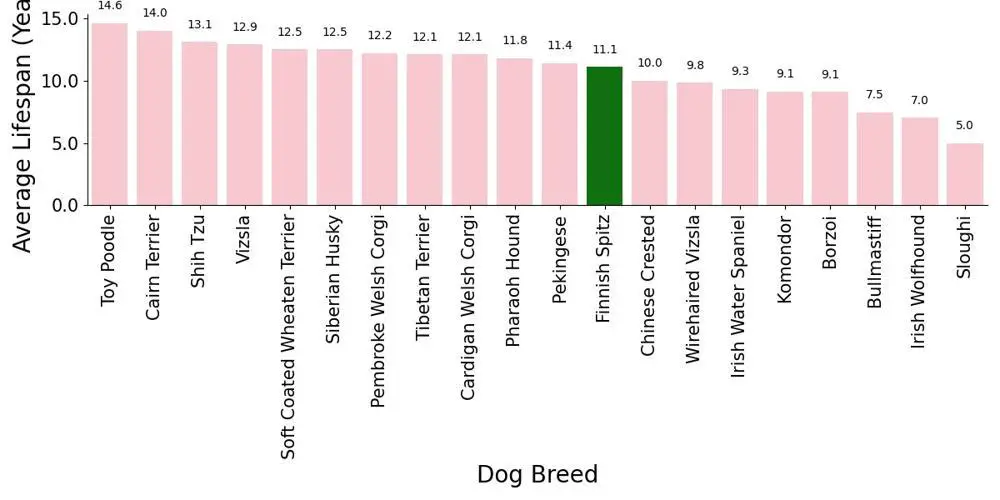
Lifespan of the Finnish Spitz Compared to Other Dog Breeds
See in the table below how the lifespan of the Finnish Spitz compares to the lifespan of other dog breeds.
| Dog Breed | Average Lifespan (Years) |
|---|---|
| Toy Poodle Lifespan | 14.60 |
| Cairn Terrier Lifespan | 14.00 |
| Shih Tzu Lifespan | 13.10 |
| Vizsla Lifespan | 12.90 |
| Soft Coated Wheaten Terrier Lifespan | 12.50 |
| Siberian Husky Lifespan | 12.50 |
| Pembroke Welsh Corgi Lifespan | 12.20 |
| Tibetan Terrier Lifespan | 12.10 |
| Cardigan Welsh Corgi Lifespan | 12.10 |
| Pharaoh Hound Lifespan | 11.80 |
| Pekingese Lifespan | 11.40 |
| Finnish Spitz Lifespan | 11.10 |
| Chinese Crested Lifespan | 10.00 |
| Wirehaired Vizsla Lifespan | 9.83 |
| Irish Water Spaniel Lifespan | 9.33 |
| Komondor Lifespan | 9.13 |
| Borzoi Lifespan | 9.08 |
| Bullmastiff Lifespan | 7.46 |
| Irish Wolfhound Lifespan | 7.04 |
| Sloughi Lifespan | 5.00 |
Common Causes of Death in Finnish Spitz, and how to Prevent Them.
We will now discuss the common causes of death in Finnish Spitz, according to scientific research. Also we will provide you advice on how to prevent these problems in your Finnish Spitz.
Here are the causes of death, starting from the most common cause
-
Neoplastic Disease in Finnish Spitzs
Neoplasms, or tumors, can be benign (like a lipoma), or malignant (cancer).
Neoplastic Disease is responsible for 27.1 percent of all deaths in Finnish Spitzs.
Causes of Neoplastic Disease in Finnish Spitz
Neoplasms in dogs, just like in people, are caused by either a genetic predisposition (like some breast cancers), an environmental factor (like smoking in humans), or a combination of both.
How to Prevent Neoplastic Disease in Finnish Spitzs
Just like in humans, there is little you can do to prevent cancers that are caused by genetic factors. You can, however, reduce the environmental risks that are associated with cancer. The `environmental` causes of neoplasia are chemical agents, infectious agents, and physical agents. An example of a chemical agent that could cause cancer in Finnish Spitzs (and humans) is asbestos. An example of an infectious agent that could cause cancer in Finnish Spitzs is the virus called canine adenovirus. An example of a physical agent that can cause cancer in Finnish Spitzs is UV radiation from the sun, just like in humans.
Another way to prevent neoplasms in Finnish Spitzs is to vaccinate them against harmful viruses, such as canine adenovirus (DHPP vaccine at 8 and 12 weeks and then once a year, every year). As in humans, early diagnosis is the key to supporting Finnish Spitzs with neoplasms, so talk to your veterinarian if you find any new lumps, bumps, or discoloration on your Finnish Spitz. You should also talk to your veterinarian if your Finnish Spitz`s gums look pale.
-
Neurologic Disease in Finnish Spitzs
These problems include canine cognitive disfunction, dementia, stroke, Lyme disease, and more.
Neurologic Disease is responsible for 16.8 percent of all deaths in Finnish Spitzs.
Causes of Neurologic Disease in Finnish Spitz
Neurological issues can be caused by vascular disease, inflammatory disease, infectious disease, metabolic disease, cancer, and developmental disorders.
How to Prevent Neurologic Disease in Finnish Spitzs
Some neurological problems can be caused by infectious agents, like Lyme disease. You should always get your dog vaccinated with the course recommended by your veterinarian.
-
Urogenital Disease in Finnish Spitzs
Urogenital problems most often involve infections and blockages, which various degrees of seriousness.
Urogenital Disease is responsible for 14.0 percent of all deaths in Finnish Spitzs.
Causes of Urogenital Disease in Finnish Spitz
Probably, the most important urogenital issue seen in intact female Finnish Spitzs is the pyometra. A pyometra is an enlarged, pus-filled uterus caused by a severe bacterial infection. A pyometra is several times larger than a regular uterus and is a life-threatening condition. To treat a pyometra, the Finnish Spitz`s uterus must be removed, which is a difficult and expensive surgery. Another urogenital infection seen in both female and male dogs is urinary tract infections, which are very similar to human UTIs. If left untreated, UTIs can ascend up the urinary tract and infect the kidneys, which can also be life-threatening. If you notice that your Finnish Spitz is urinating much more or less frequently than usual, or if the color or smell of the urine seems different from normal, you should talk to your veterinarian. Another common urogenital issue in male Finnish Spitzs is urinary blockages, which (as the name suggests) is when there is something stuck in the urinary tract which prevents the Finnish Spitz from urinating. If you see your Finnish Spitz lifting its leg and trying to urinate but nothing is coming out, you should call your veterinarian. Cancer is also a major urogenital issue in Finnish Spitzs, just like it is in humans. Urinary incontinence can also be an issue in both male and female Finnish Spitzs, just like in humans.
How to Prevent Urogenital Disease in Finnish Spitzs
The only way to completely prevent a pyometra is by getting your female Finnish Spitz spayed. Another major benefit to spaying your Finnish Spitz is that it dramatically reduces her risk of breast cancer. A spay is a major surgery and does tend to be a bit more expensive than a neuter, but a pyometra surgery is probably 3-4 times more expensive and dangerous than a regular, routine spay. Neutering your male Finnish Spitz will also dramatically reduce his risk of prostate cancer and urinary blockages, especially as he gets older. If the spay and neuter estimates from your regular veterinarian are a little out of your price range, low-cost high-volume (LCHV) spay and neuter clinics are also an excellent option. If you find that your Finnish Spitz is prone to blockages even though they are sterilized, there are many diets and supplements like this that can help. There are also diets like this and supplements that can help with urinary incontinence, but if these don`t work, your veterinarian can also prescribe prescription medications.
-
Infectious Disease in Finnish Spitzs
There are many types of infectious diseases: bacterial, viral, parasitic, and fungal infections. Different diseases have different causes and they affect different parts of the body. For example, E. coli causes an infection in the intestines which can cause diarrhea in humans and dogs, whereas Demodex is a parasite on dog skin.
Infectious Disease is responsible for 13.1 percent of all deaths in Finnish Spitzs.
Causes of Infectious Disease in Finnish Spitz
All infectious agents fall into two categories: the ones that invade the body from the outside, and the ones that are living in or on the body that experience an overgrowth. For example, staphylococcus aureus is a normal bacteria found on the skin; however, it can cause skin infections if its growth gets out of hand. Both types of infectious agents can be stopped by the body`s immune response. Internal infectious agents can also be prevented by probiotics.
How to Prevent Infectious Disease in Finnish Spitzs
If your Finnish Spitz seems like they are not doing well, you should take them to the veterinarian so they can decide if your dog needs antibiotics, fluids, a dewormer, or other therapies. When your Finnish Spitz is well, you can support their immune health through nutrition, probiotics like this and vitamins.
-
Respiratory Disease in Finnish Spitzs
Respiratory diseases includes asthma, bronchitis, pneumonia, and other conditions. May also be related to left-sided heart failure and other cardiovascular issues.
Respiratory Disease is responsible for 11.2 percent of all deaths in Finnish Spitzs.
Causes of Respiratory Disease in Finnish Spitz
Some lung conditions can be caused by bacteria, viruses, and parasites. Other lung conditions, such as asthma, can be related to allergies and genetic conditions. Some breeds (called brachycephalic breeds) are more susceptible to breathing problems. These breeds appear to have their noses and snouts kind of squished into their faces. Although they are very cute, these breeds can have serious breathing problems throughout their lives which may require surgery. Additionally, dogs and cats can often get colds and other upper respiratory infections because of stress. Common causes of stress in dogs include separation anxiety, thunderstorms and other loud noises, the introduction of other animals into the home, and more.
How to Prevent Respiratory Disease in Finnish Spitzs
Respiratory diseases can be prevented by supporting the immune health of your Finnish Spitz, by making sure you feed your Finnish Spitz a good, nutritious dog food brand, give them plenty of exercises, and help them live in a stress-free environment. There are several options for supplements and therapies that can help reduce stress in your Finnish Spitz. Some Finnish Spitz do really well with thundershirts, which are snug shirts that swaddle the dogs and help them calm down during thunderstorms and other stressful events. Furthermore, Finnish Spitzs that are anxious with loud sounds might also benefit from calming supplements, such as Anxiety TFLN. For general anxiety, the supplement Composure or Composure Pro might help calm your Finnish Spitz`s nervousness. Some Finnish Spitzs do really well with supplements, but just like with people, supplements do not work for everyone. If you are not seeing results after a few weeks of putting your Finnish Spitz on a supplement to calm anxiety, you should talk to your veterinarian about behavioral therapy and stronger medications.
How Old is Your Finnish Spitz in Human Years
The table below shows your human years equivalent age of your Finnish Spitz. This table is based on a dog-to-human age study conducted by researchers from Purdue University.
Learn more about how old your Finnish Spitz is in human years here.
In 1997, researchers from Purdue University developed a method for converting a dog`s age to its human age. Their method was based on the 1953 work of the French Veterinarian, A. Lebeau that we discussed above.
Researchers from Purdue University took Lebeau`s work further by taking into account two important factors to develop a more accurate method for converting a dog`s age into its human equivalent age:
- The size of the dog: Smaller dog breeds live longer than larger breed dogs
- The lifespan of the dog: Dog breeds that live longer lives will age slower than dog breeds that live shorter lives
The average lifespan of the Finnish Spitz is 11.1 years.
Finnish Spitzs are medium-sized dogs. Finnish Spitzs weigh 20 to 35 pounds.
The method developed by the Purdue University veterinarian researchers took into account the lifespan and size of Finnish Spitz in converting Finnish Spitz age to human age.
The researchers used data on the lifespan and weight of 5,608 mixed breed dogs and 17,927 purebred dogs to develop their method for converting the ages of dogs (of different breed sizes and lifespans ) to their equivalent human ages.
The calculator below lets you convert your Finnish Spitz`s age to its human age based on the Purdue University method. Just enter your Finnish Spitz`s age in the calculator and it will compute your Finnish Spitz`s human age. If you do not know your Finnish Spitz`s exact age, enter an approximate age in the calculator.
Also, the table below shows how old your Finnish Spitz is in human years based on the method developed by the researchers.
Note that your Finnish Spitz`s human age changes day by day. Therefore, always check back to use the calculator to find your Finnish Spitz`s up-to-date human age.
Finnish Spitz Age to Human Age Calculator (Purdue Uni. Method)
Below is a Finnish Spitz age to human age calculator that is based on the methods developed by researchers from Purdue University.
The calculator will tell your Finnish Spitz`s human age based on your Finnish Spitz`s dog birthday. Also, the calculator will tell you which day is your Finnish Spitz`s human birthday! Try it out!
| Finnish Spitz Age (Years) | Human Age (Years) |
|---|---|
| 1 | 14 |
| 2 | 21 |
| 3 | 26 |
| 4 | 32 |
| 5 | 37 |
| 6 | 42 |
| 7 | 46 |
| 8 | 50 |
| 9 | 54 |
| 10 | 58 |
| 11 | 62 |
| 12 | 66 |
| 13 | 71 |
| 14 | 75 |
| 15 | 80 |
| 16 | 85 |
How Long Do Finnish Spitzs Live in Human Years?
The average lifespan of the Finnish Spitz is 11.1 years. In human years, the Finnish Spitz lives for 63 years.
How Old is 1-year-old Finnish Spitz in Human Years?
A 1-year old Finnish Spitz is 14 years old in human years.
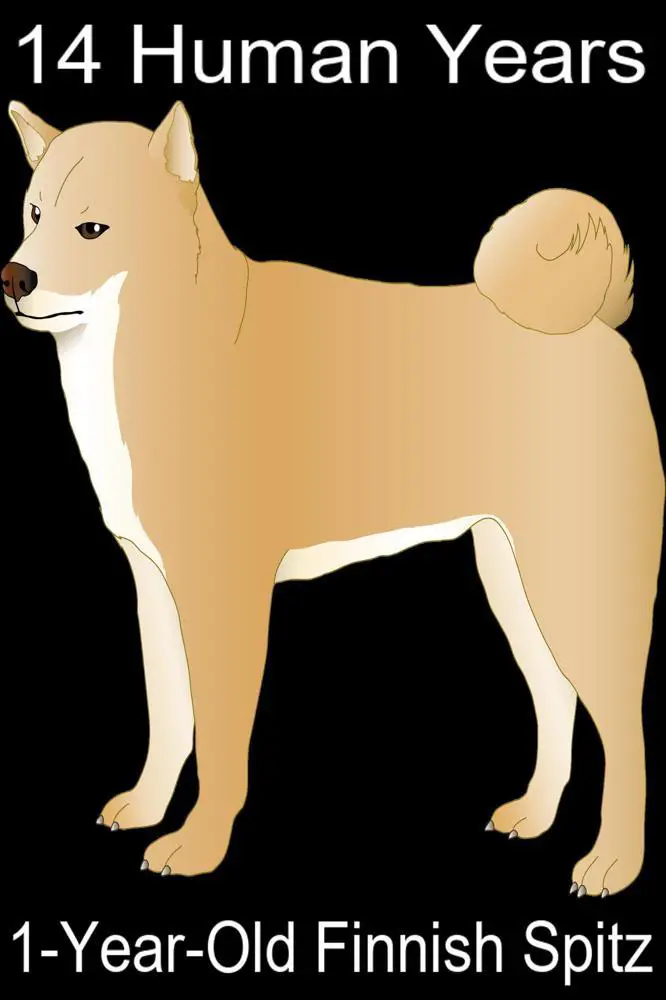
How Old is 2-year-old Finnish Spitz in Human Years?
A 2-year old Finnish Spitz is 21 years old in human years.
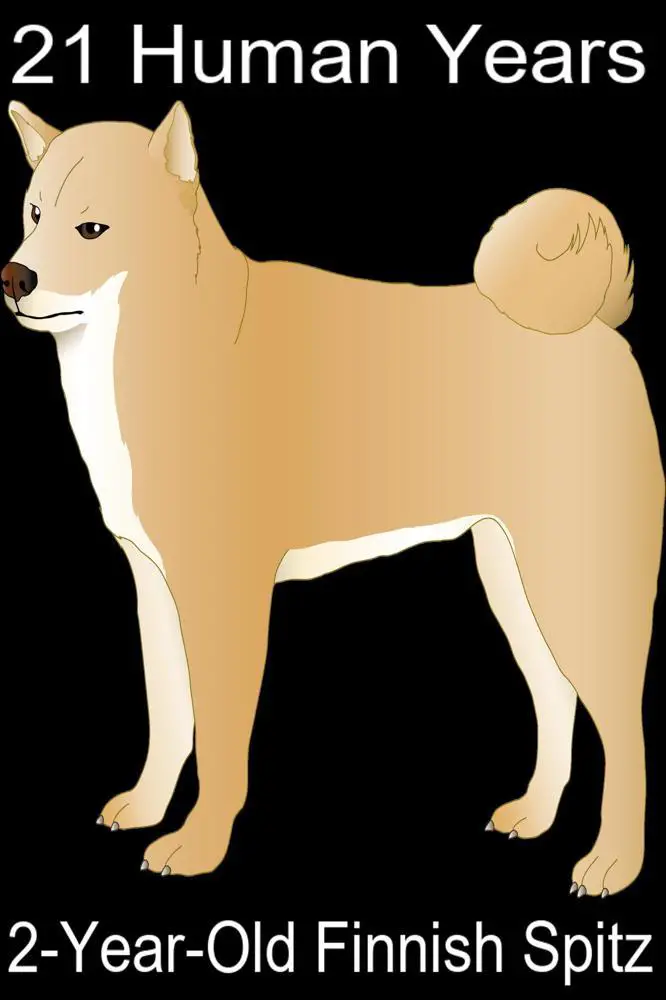
How Old is 8-year-old Finnish Spitz in Human Years?
A 8-year old Finnish Spitz is 50 years old in human years.
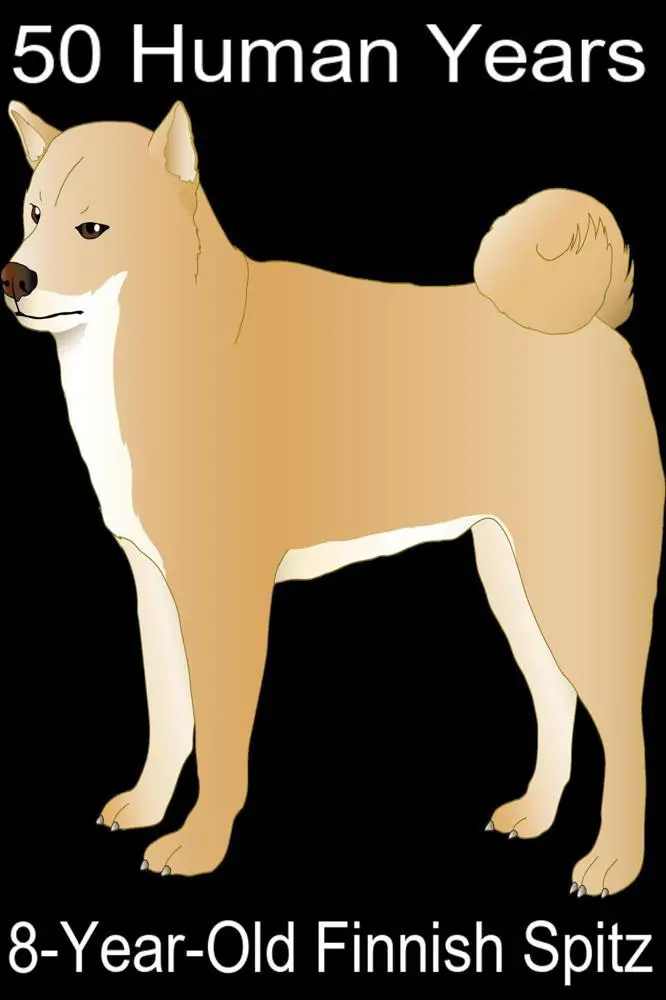
How Old is 10-year-old Finnish Spitz in Human Years?
A 10-year old Finnish Spitz is 58 years old in human years.
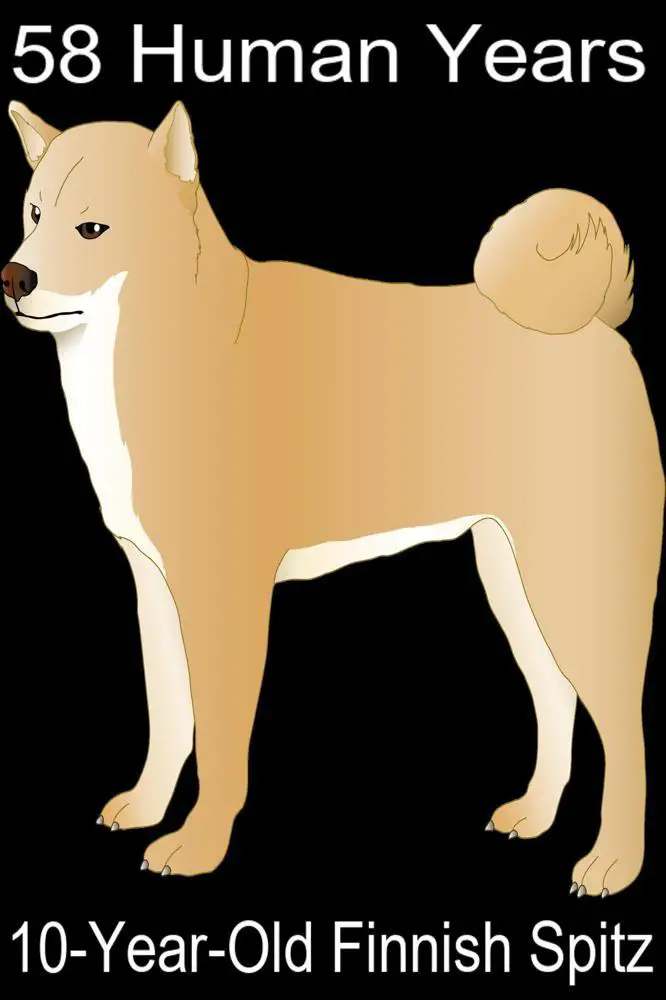
More Ways to Make Your Finnish Spitz Live Long
Here are more things your can do to make sure your Finnish Spitz live a long life:
-
Regular Exercise: Research studies have shown that one of the very effective ways to make a dog live long is to ensure that a dog is in good shape. Adequate exercise will make your Finnish Spitz fit and make it live longer.
-
Good Diet: A poorly-fed, underweight Finnish Spitz does not have a good chance of living a long life. Similarly, an overweight Finnish Spitz will have a shorter lifespan than a Finnish Spitz that is of normal weight. Therefore, it is important that your feed your Finnish Spitz high-quality dog food without overfeeding your Finnish Spitz. Check out our Finnish Spitz feeding guide here. Learn how you can prevent your Finnish Spitz from being overweight here.
-
Proper Hydration: Water is essential for your Finnish Spitz existence. Therefore, you should make sure your Finnish Spitz has access to clean water whenever your Finnish Spitz needs water. However, too much water is bad for your Finnish Spitz. See our Finnish Spitz water drinking guide to learn more on how to properly hydrate your Finnish Spitz.
-
Spaying/Neutering: Sterilizing your Finnish Spitz might prolong its life. Check out this guideline to know when it is the best time to spay/neuter your Finnish Spitz.
-
Routine Vet Care: Regular preventative visits to the vet can help catch diseases early.
-
Vaccinations: Always make sure your Finnish Spitz is up to date on its vaccination.
-
Dental Hygiene: Your Finnish Spitz’s teeth can get infected, and if the infection goes unnoticed, that infection can spread to other parts of the body and become systemic. This could lead to a shortened lifespan. You must have your Finnish Spitz teeth cleaned professionally at your vet’s office a couple of times in its lifetime. Talk with your vet about the best ages to have these cleanings done.
Conclusion on Finnish Spitz Life Expectancy
We hope the information we have provided will help your in increasing your Finnish Spitz`s life expectancy.
Tate Ackerman contributed to this article. Tate is a second-year veterinary student at Kansas State University. Tate is also a concurrent Ph.D. student. She has a lot of experience reading scientific literature and communicating that information to a non-veterinary audience. Tate was a veterinary technician for a companion animal practice before she applied to veterinary school.